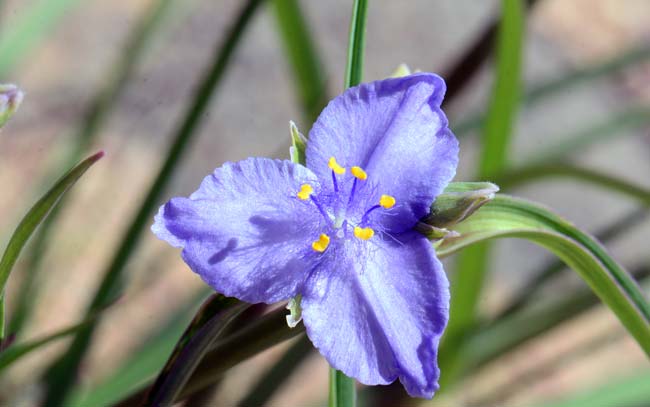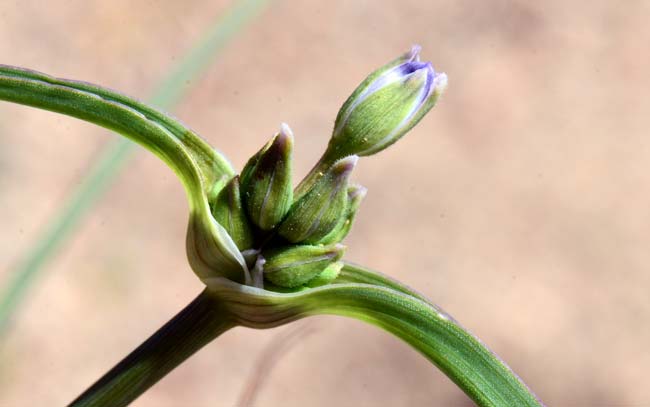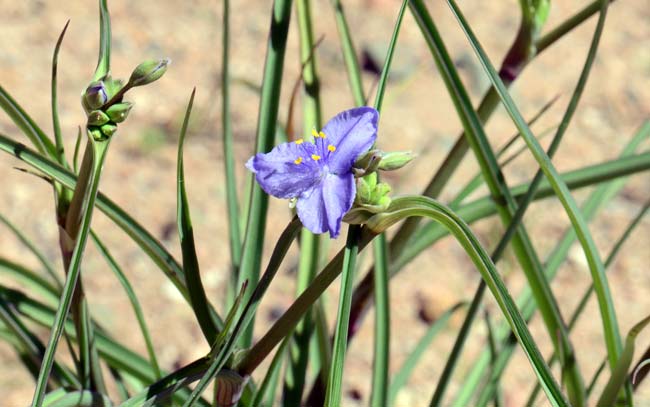Tradescantia occidentalis, Prairie Spiderwort



Scientific Name: Tradescantia occidentalis
Common Name: Prairie Spiderwort
Also Called: Spiderwort, Western Spiderwort
Family: Commelinaceae, Dayflower or Spiderwort Family
Synonyms: ()
Status: Native
Duration: Perennial
Size: 24 inches.
Growth Form: Forb/herb; erect or ascending; stems branching, glabrous.
Leaves: Green; long linear, narrow or lanceolate.
Flower Color: Blue, purple or violet; flowers in clusters on tips of branches, axillary, 6 stamens with distinctive yellow anthers, blooms last a day and flowers close early.
Flowering Season: April to September.
Elevation: 2,500 to 7,000 feet.
Habitat Preferences: Sandy soils, various habitat types, upper Sonoran desert but mostly found in higher elevations with woodlands.
Recorded Range: Central portions of the United States and Canada and New York and New Jersey; USA: AR AZ, CO, IA, KS, LA, MN, MT, ND, NE, NJ, NM, NY, OK, SD, TX, UT, WI and WY and Canada: AB, MB and SK. Possibly in northern Mexico.
In Arizona Prairie Spiderwort in found in the central part of state in northern, central and southern areas.
North America & US County Distribution Map for Tradescantia occidentalis.
U.S. Weed Information: No data available.
Invasive/Noxious Weed Information: No data available.
Wetland Indicator: In North America Tradescantia occidentalis is included on the USDA 2012 National Wetland Plant List as a: (FACU) Facultative Upland, usually occur in non-wetlands, but may occur in wetlands; (UPL) Obligate Upland, almost never occur in wetlands and (FACW) Facultative Wetland, usually occur in wetlands, but may occur in non-wetlands species.
Threatened/Endangered Information: Tradescantia occidentalis is listed as a threatened species in Canada.
Tradescantia occidentalis var. melanthera, Prairie Spiderwort (AR, LA, OK and TX)
Tradescantia occidentalis var. occidentalis, Prairie Spiderwort (see Recorded Range above) and
Tradescantia occidentalis var. scopulorum, Prairie Spiderwort (AZ, CO, NM and UT).
Comments: Prairie Spiderwort is a species found throughout the central portions of the United States and Canada in prairies and open woodlands. Species in Arizona mark the southwestern limits of the type species although 2 varieties; "scopulorum", and "melanthera", have distributions limited to the southwest and south central United States.
Prairie Spiderwort is similar in appearance to Whitemouth Dayflower, Commelina erecta.

